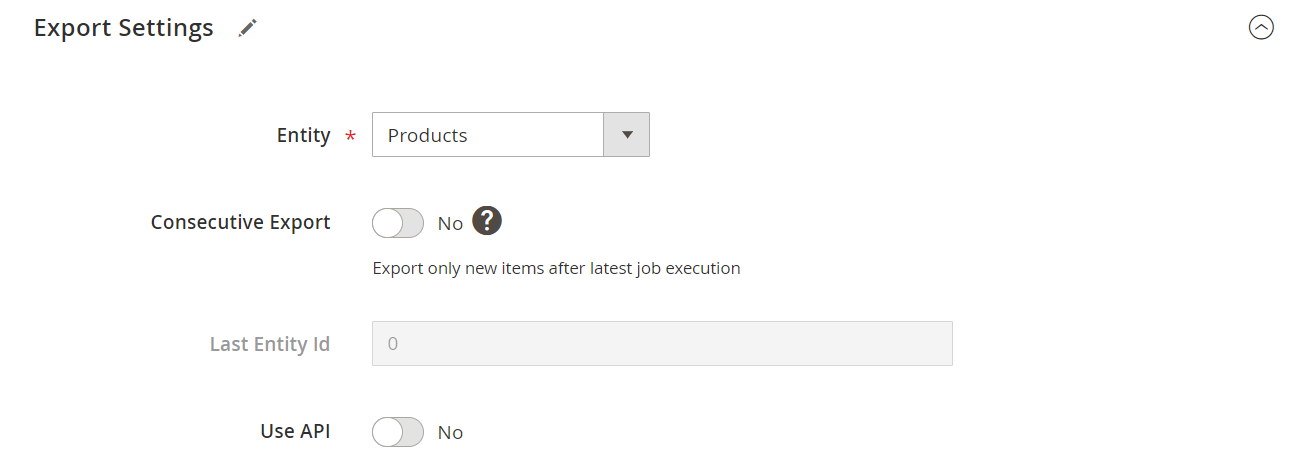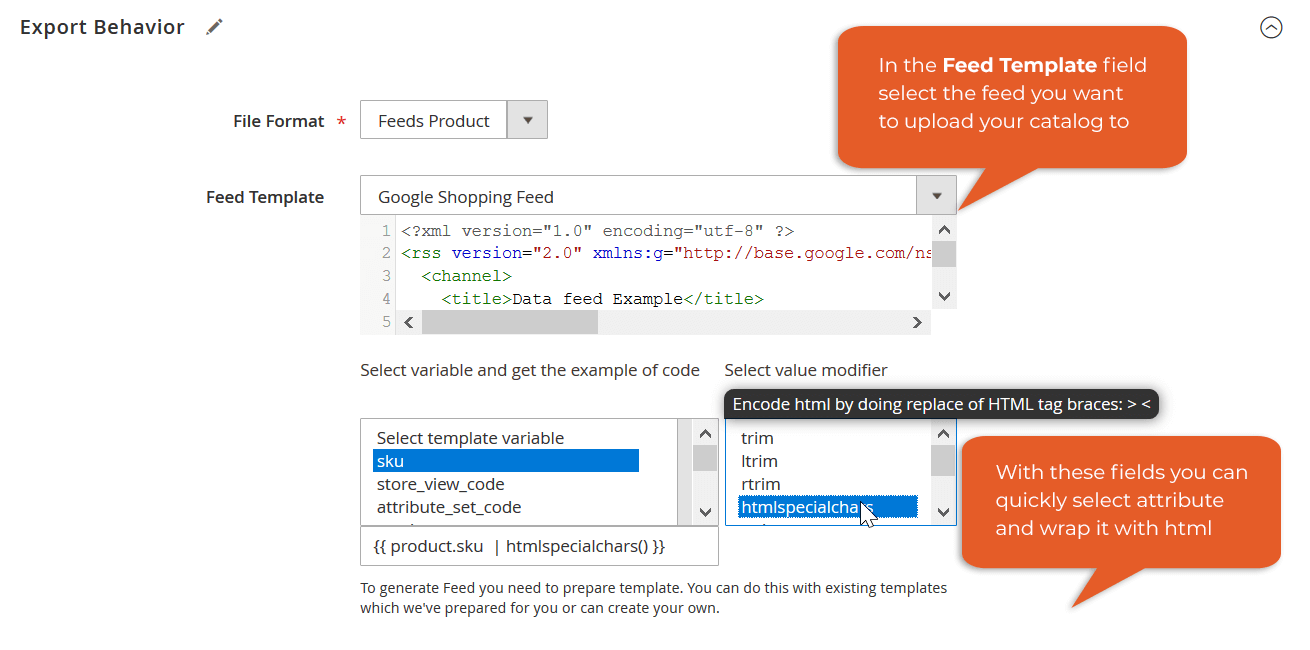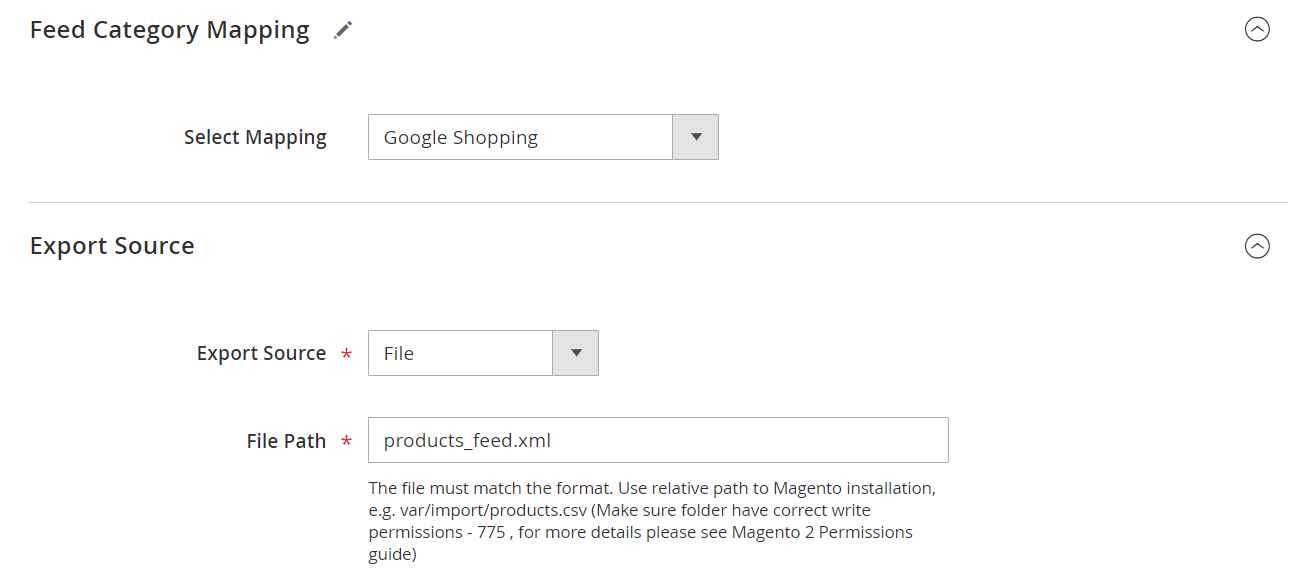Manual for Product Feed Export Add-on of Improved Import and Export

Welcome to the manual for the free Magento 2 Product Export Add-on of the Improved Import and Export extension. This tool is developed to simplify your integration with all kinds of services that require your product feed: Amazon, eBay, Facebook, or even drop shippers – provide all of them with your catalog in the form of a feed.
In the article below, we shed light on what the Magento 2 Product Export Add-on of the Improved Import and Export extension is. After that, you will find a guide on how to install the tool. We also explain how the add-on works, including such aspects as feed category mapping and product feed export jobs.

Table of contents
- 1 What is it
- 2 How it works
- 3 Use Cases
- 3.1 Magento 2 Product Feed Export Add-on FAQ
- 3.1.1 What is the Magento 2 Product Feed Export add-on for Improved Import and Export?
- 3.1.2 What product types does the Magento 2 Product Feed Export add-on support?
- 3.1.3 How to create an output that follows the requirements of an external marketplace?
- 3.1.4 What file types are suitable for the feed?
- 3.1.5 How does the Magento 2 Product Feed Export add-on for Improved Import and Export work?
- 3.1 Magento 2 Product Feed Export Add-on FAQ
What is it
The Free Magento 2 Product Feed Export add-on for Improved Import and Export is the piece of software that allows merchants to convert their product into feeds and place them on third-party marketplaces to increase promotion impact.
With the tool, you are able to transform your catalog into offers ready to be implemented into another system with all required mapping automatically applied. Using the software, you can create Facebook, Google Shopping, eBay, and other product feeds and boost your store presence by getting multiple channels for advertising.
The add-on uses the logic of Improved Import and Export and requires the extension to be installed into your store before unpacking the add-on data. If you still don’t know what Improved Import and Export can bring to your store, see the extension’s feature list:
- Import and export of all product types and Magento 2 entities.
- Entity attribute mapping – to ensure the imported and exported values match the required Magento 2 attribute names.
- Support of CSV, XML, XLSX, ODS, Json, ZIP, and TAR file types.
- Import table mapping for separators and other values.
- XSLT templates for XML files. Import any XML file structure.
- Support of direct file upload, FTP/SFTP, REST API, SOAP API, Dropbox.
- Support of Google Drive and Google Sheets import. Tables can be imported and exported directly from/to Google Sheets and retrieved and saved to a folder in Google Drive.
- Price adjustments for imported products.
- 100% open code, no limitations.
- Customization module with the endpoints for future integrations.
Installing Product Feed Export add-on for Improved Import and Export
NOTE: Before installing the Product Feed Export Add-On make sure you have the Improved Import and Export extension installed.
1. Navigate to your store root folder in the SSH console of your server:
|
1 |
cd path_to_the_store_root_folder |
2. Install Product Feed Export Add-On by running the command:
|
1 |
composer require firebear/importexport-feeds |
3. Enable Product Feed Export Add-On by running:
|
1 |
php bin/magento module:enable Firebear_PlatformFeeds |
4. Deploy content and flush store cache, log out from the backend and log in again. Run:
|
1 |
php bin/magento setup:static-content:deploy -f |
and:
|
1 |
php -f bin/magento cache:clean |
Congratulations, you have installed the Product Feed Export add-on for Improved Import and Export extension.
How it works
The Magento 2 Free Product Feed Export add-on involves two stages of enabling feed generation. First, you should map the categories of your store to those of the platform you send feeds to. Then you proceed with the actual feed export where you create product feeds and apply the mapped categories to them.
Let’s take a look at the process in detail.
Feed Category Mapping
To start exporting your feeds you should first configure mapping presets for categories your product will belong to at another platform.
You can set up feed category mapping at System > Improved Import/Export > Feed Category Mapping.

All the presets you can find in the grid with their IDs, titles, types specified. The presets are open for editing upon clicking the ‘Edit’ button.
To create a new mapping, click on the ‘Add New Mapping’ button.
Once you are on the New Mapping page, you first need to give a name to your preset. Then you decide what type to assign to the current mapping, e.g., Google, Facebook, etc.

To retrieve data about categories, activate the ‘Get Categories’ button. Now you have all the existing categories from your target platform ready to be matched with the categories of your store.
In the ‘Magento Category’ field, you can select a category from your store. The ‘Feed Category’ section is where you choose which category your products from previously selected Magento 2 categories will be assigned to. You can type three starting letters of the feed category name for the functionality to display the suggestions.

Once you’ve done building the preset, don’t forget to save the mapping by clicking the relevant button at the top-right corner of the page.
NOTE that you can’t change the mapping type (Google, Facebook, etc.) once you’ve saved the preset. To select another type, create a new mapping.
If you’ve cleared the cache, you need to re-visit the category mapping pages and get all the feed categories retrieved once again. The feed category mapping includes the file with category associations and the list of such associations per mapping rule. As the list of mapped categories is stored up in cache it needs to be retrieved once again if you’ve previously cleared cache.
Product Feed Export Job
The export job configuration can be done at System > Improved Import/Export > Export Job. The export process is standard for the Improved Import and Export functionality; for the details visit the extension manual page. However, the add-on logic has its specifics which we’ll focus on below.
Create a new job by clicking the ‘Add New Job’ button. Give the job name and decide whether you want to export feeds automatically with cron, upon Magento 2 events, or your job will be run only manually.

To export Magento 2 product feeds, you need to select ‘Products’ as an entity type. Configure the additional export settings, such as consecutive export, store view filter, etc., if you need to.

The ‘Export Behavior’ section is where you get the template for future feed generation. Select product feeds as a format for export logic, then proceed with feed template management.
By default, the template is empty in case you want to create it from scratch. To get the built-in template that corresponds to one of the existing mapping preset, select the relevant platform title in the dropdown on the ‘Feed Template’ section (e.g., Google Shopping Feed). If you need to change something in the feed code, you can change it right in the template body.

In the ‘Feed Category Mapping’ section, specify the preset you’ve previously created.
You can choose the export sources and file format for your product feeds in the ‘Export Source’ section. Here you can decide what format will suit best the target platform for your feeds. As Improved Import and Export — on which the Produce Feed Export add-on is built — supports various sources and file formats, you can get the best experience of getting your export file and its further management.
Before running the job don’t forget to apply product filters. Make sure you export products that belong to the categories you’ve specified in the feed category mapping.
Once you’ve done with the configuration, you can run the product feed export job.
Use Cases
You are a merchant who wants to increase their offers’ visibility and try a new platform for selling your products? The Magento 2 Product Feed Export add-on for Improved Import and Export will provide you with the ability to extract product data from the database in the form of a feed.
If you have no free time on dealing with product data and product content modifications, feeds require no involvement from your side. The add-on transforms your products into feeds and assigns categories from the target database to them automatically, as well as maps data so that it can be processed at the marketplace of your choice.
In case you export your catalog as product feeds to Facebook. With the add-on, you get the product feeds in any format that suits your goals and is comfortable for working with. The add-on supports XML, CSV, TSV, RSS, ATOM XM, TXT, and many more export file formats.
Do you need to expand the list of reliable promotion scenes and increase the efficiency of your promos? Magento 2 Product Feed Export add-on opens gates for you to enter the Amazon community. Format your products automatically or manually to implement them into the Amazon inventory without any losses. Promote your offers to mass audiences via Amazon ads.
Magento 2 Product Feed Export Add-on FAQ
Let’s take a look at some questions that people often ask when it comes to the Magento 2 Product Export Add-on of the Improved Import and Export extension.
What is the Magento 2 Product Feed Export add-on for Improved Import and Export?
Consider the add-on a piece of software that provides the ability to convert your products into a feed and place it on the third-party marketplaces.
What product types does the Magento 2 Product Feed Export add-on support?
The add-on lets you import and export products of all types. Since it works on top of the Improved Import & Export extension, you also get the ability to transfer all other Magento 2 entities.
How to create an output that follows the requirements of an external marketplace?
The Magento 2 Product Feed Export add-on inherits the robust mapping capabilities of the Improved Import and Export extension. It means that you can show what Magento attributes should be replaced with external ones to match the requirements of a marketplace that you are going to provide with a product feed.
What file types are suitable for the feed?
With the help of our add-on, you can freely create product feeds in CSV, XML, XLSX, ODS, and JSON formats. Note that import processes also let you transfer compressed files of these types if the archive is in a TAR or ZIP format.
How does the Magento 2 Product Feed Export add-on for Improved Import and Export work?
Exporting a data feed with the Magento 2 Free Product Feed Export add-on involves two stages. Firstly, you map your store categories to those of the platform you send feeds to. Secondly, you run the actual feed export, creating product feeds and applying the mapped categories to them. You can find more information in the article above.

